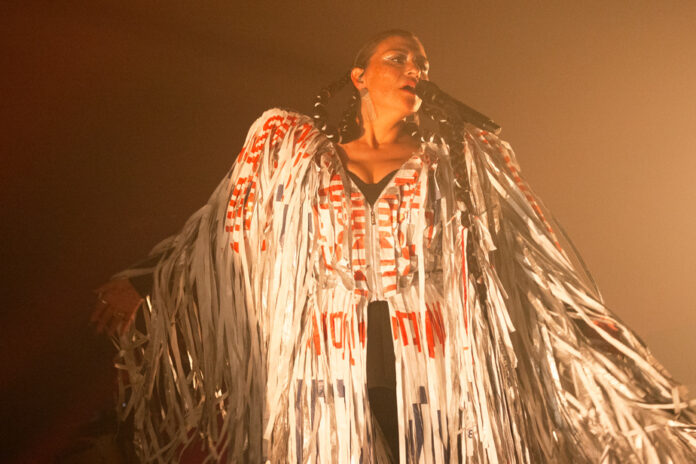On stage, among the smoke that perfumes Factory C all the way into the hall, a large glittering boombox, the kind that teenagers carried around before the advent of smartphones. It is the voice of Elisapie that will emerge – Elisapie as a radio host – as at the time when, from the age of 14, she held the microphone on the airwaves of TNI, the Nunavik station.
You’re listening to Radio Uvattini, she announces softly, in Inuktitut, before introducing I Have a Dream by ABBA, a chorus in which the Swedish icons rejoice in being able to aspire to a dream, a dream that helps them get through darkness, mile after mile, waiting to reach their destination.
Elisapie would reach her destination a few seconds later by appearing on the stage of Factory C dressed in a majestic white and red jacket with shoulder pads, made up of long fringes, a costume created by the Anishinaabe visual artist Caroline Monnet from construction materials (materials that she also uses in her paintings and installations, in order to denounce the housing crisis that is hitting so many Indigenous communities across Canada).
After Uummati Attanarsimat (Heart of Glass), it was time for Taimangalimaaq (Time After Time), a rereading set with a lap steel score by the essential Joe Grass, which brought out dazzling highlights in this surprisingly melancholy melody.
“If you’re lost, you can look and you will find me”, proclaims Lauper in the original version of this 1983 success, and that is indeed the strength of Elisapie, that of a guide helping us to confront the painful darkness of our intimate memories as well as the history of a country where a human life probably does not have the same value, whether one is born in the North or the South.
Essentially built around covers of pop hits, translated into her mother tongue, from her most recent album, Inuktitut, this show entitled Uvattini could be considered as a luxury version of the one she will be carrying around all over Quebec in the coming months .
Directed by the Anichinabe playwright Émilie Monnet, this dive into the singer’s musical-affective past is based on the same insight as that animating her record: Elisapie knew too well that these immortals of the FM band of the 1970s and 1980s carry in their hearts the ghosts of the people we loved. Elisapie will confide several times about those whose voices she hears in these refrains as heady as our most precious memories.
Elisapie is 2 years old, therefore, and rides with her older brother on his motorcycle, among the vastness of the territory, a few months before he lost his life in a fire. “He really liked this song,” she would add as she sang Sinnatuumait (Dreams) by Fleetwood Mac, while in the back, on the giant screen, images of a young man were projected on a “ gas bicycle” with, sitting between his legs, a little face covered with a fur hat. All around them: sky as far as the eye can see.
Supported by five musicians ardently invested in each of their interpretations, Elisapie would also draw from her previous albums, notably during the time of a gripping version with only two guitars of Me, Elsie and another, cut up by projections of noise rock and of free jazz, by Arnaq, during which Jean-Sébastien Williams (guitar), Jérémie Essiambre (drums) and Jason Sharp (bass saxophone) particularly shone. On throat singing and qilaut (a drum), Silvia Cloutier sometimes joined them, because if this show is aimed at the universal, it is first and foremost rooted in a culture to which Quebec theaters still too rarely open the door. door.
“We have to stop asking ourselves questions, we have to go where it hurts,” Elisapie would say, confiding that she has learned to “no longer feel” the pain that the numerous suicides in her community burn within her, before dedicating Qimatsilunga (I Want to Break Free) to one of his cousins, a handsome and gentle boy, who liked to wear pink and purple when he came to Montreal, and with whom he would have loved to dance. His Qaisimalaurittuq (Wish You Were Here), offered at the end of the curtain around a single microphone, almost a cappella, was also addressed to all those departed whose absence we mourn.
What could real reconciliation between indigenous and non-indigenous people look like? we often ask ourselves. As a final reminder, Elisapie would invite everyone who wanted to join her on stage, to dance to the sound of Inuuniaravit (Born to Be Alive).
Non-native and indigenous people, children and old people, men and women then surrounded him in the fabulous carefreeness of a disco rhythm, as if to remind us that this is what indigenous people are still deprived of: true carefreeness which can only occur when one no longer has to worry about surviving, but only about living.















